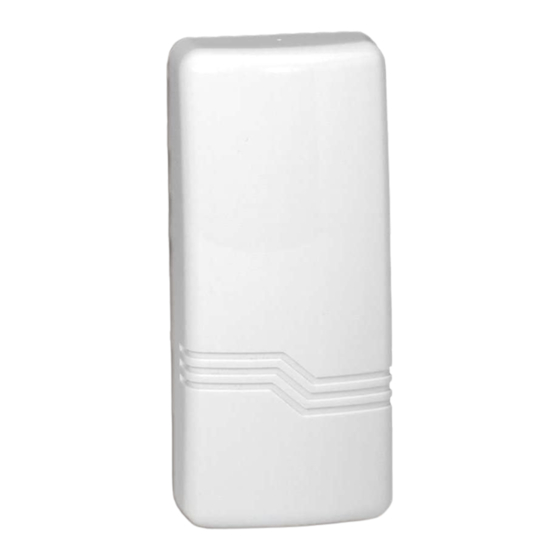ADEMCO 5817CB 설치 및 설정 매뉴얼
{카테고리_이름} ADEMCO 5817CB에 대한 설치 및 설정 매뉴얼을 온라인으로 검색하거나 PDF를 다운로드하세요. ADEMCO 5817CB 2 페이지. Wireless commercial /
household transmitter
ADEMCO 5817CB에 대해서도 마찬가지입니다: 설치 지침 (4 페이지), 빠른 시작 매뉴얼 (2 페이지), 설치 지침 (2 페이지), 설치 및 설정 매뉴얼 (2 페이지)

ADEMCO 5817CB
General Information
The 5817CB is a universal contact-monitoring transmitter that can be used with household and commercial fire and burglary-initiating devices such as
door/window contacts, motion and glassbreak detectors, sprinkler water flow switches, tamper switches, post indicator valves, manual pull stations,
and remote duct detectors. Upon activation, it emits an RF signal to a control panel that sends a burglary or fire alarm to a central station. The 5817CB
has three unique input loops (zones).
• The first loop (primary loop) is supervised and typically used for high-priority alarm reporting such as commercial fire or burglary. It requires a 470K
ohm end-of-line resistor (PN EOLR 470K) to be placed across the sensor.
• The second loop is the built-in, normally closed reed switch (used in conjunction with a magnet, as described below).
• The third loop is another normally closed household burglary loop. All three loops may be used.
• A fourth (automatically enrolled) loop contains two tamper switches to protect the 5817CB transmitter. A built-in cover tamper switch is activated
when the cover is removed. A unit tamper switch is activated if the unit is separated from its mounting plate.
1
Programming
The 5817CB has its own unique serial number permanently assigned during manufacture. You must "enroll" this transmitter serial number in the
control panel at some point prior to its usage in the alarm system. Refer to the control panel's installation instructions for specific programming
procedure.
Note: During programming of the control panel, program the 5817CB transmitter as Input Type "RF" (i.e., supervised RF) (mandatory for UL
installations).
2
Mounting
The 5817CB is supplied with a tamper switch hold-down (in the plastic parts bag) for use when the wall mounting plate is not needed. For proper
orientation of the unit in relation to its wall mounting plate and the loop wiring, read all of this section before installing the unit. Signal strength may vary
from location to location. Before mounting the transmitter permanently, conduct Go/No Go tests (see control's instructions) to verify adequate signal
strength from this location. When a satisfactory location is found, make note of the position of the unit on the wall, remove the battery and proceed
with installation.
!
Do not mount the transmitter on or near metal objects, as this may affect transmission range. It is also good practice to avoid
locating the transmitter near wiring such as AC, telephone, HVAC, computer data cables, etc.
The following mounting instructions assume that the unit will be
mounted as shown in the Figures. The unit may, however, be installed
in any direction, as long as the relationship of the unit to its mounting
plate (if used), is maintained.
The 5817CB is supplied with a tamper switch hold-down tab (connected
to the mounting plate as shown in Figure 1), for use when the wall
mounting plate is not needed. Remove the tab with diagonal cutting
pliers.
The mounting plate, installed as described below, enables easy removal
of the unit for servicing.
1. Remove the transmitter's cover by inserting the flat blade of a
small screwdriver into the pry-off slot at the bottom end of the unit
on the right side closest to the cover's decorative ribs and twisting.
2. Disengage the supplied mounting plate from the unit by
inserting the blade of a small screwdriver into the mounting plate
release hole (see Figure 3) and pushing the locking tab out (see
Figure 1). Slide the mounting plate downward along the case back.
Note: For this application, the alignment guide strip along one edge
of the mounting plate serves no function and may be broken away,
if desired.
3. If concealed wiring is to be used, feed the wires through the
concealed wiring entry hole at one corner of the mounting plate
(and/or case back). Surface wiring is discussed in Step 5 below).
4. Install the mounting plate, with its case-holding posts pointing up,
in the location determined. Use two flat head dry-wall screws.
Note: To ensure proper operation of the unit's back tamper (when it
is separated from the mounting plate), the screws must be anchored
to a wall stud or other solid wood material. If the mounting plate
will not be used, make note of the location of the tamper switch
hold-down as shown in Fig. 1 for the proper placing of the hold-
down tab in Fig. 2.
5. If surface wiring is to be used, remove the knockout slot in the
case back (located across from loop 3 terminal block). Surface
wiring should enter through this knocked out space provided. Do
not connect the wiring to the terminal block(s) yet.
6. Attach the case back to the mounting plate by sliding the keyhole
slots in the case back down onto the mounting plate's holding posts.
The locking tab will click as the case back locks in place.
To disengage the unit from an installed mounting plate, insert a
Wireless Commercial/Household Transmitter
Installation and Setup Guide
NOTE: For UL commercial and household fire installations, only one
initiating device may be connected to this transmitter. For UL commercial
burglary installations, multiple initiating devices may be used as long as the
devices all serve the same function, such as door/window contacts, motion
or glassbreak detectors. All initiating devices must be located within the
same room.
No more than one wire per terminal may be connected.
Use only 14-22AWG wire.
Figure 1. Mounting Plate
Figure 3. 5817CB Transmitter, Top Cover Removed
Figure 2. Case Back
